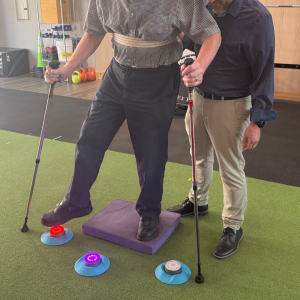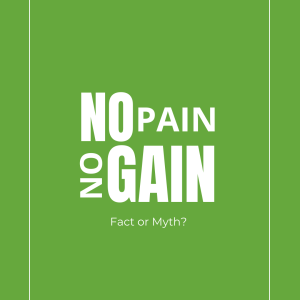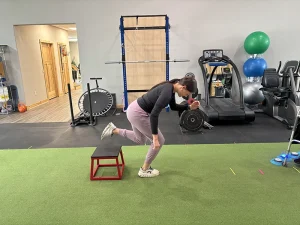By: Dr. Marissa Anderson, PT, DPT
If you’ve noticed a growing group of people in your local park hitting a plastic ball back and forth with paddles – often accompanied by laughter and a bit of friendly competition – chances are, you’ve discovered pickleball.
As a physical therapist, I see trends in fitness come and go. But pickleball? This one is here to stay! It’s fun, social, and accessible to competitors of all ages. Like any sport, pickleball comes with its fair share of risks when it comes to the musculoskeletal system — which, if ignored, can turn your sweet new hobby into a potentially sour experience.
Let’s take some time and dive into the health benefits, common injuries, and injury prevention in pickleball to ensure to keep your body on the court.
Curious About Pickleball? Let’s Break It Down
Pickleball is a paddle sport that combines various elements of tennis, badminton, and ping-pong. When compared to tennis, pickleball is played on a smaller court and players volley a plastic ball back and forth over a short net. The game can be played in singles or doubles, and the fast-paced yet low-impact nature of the game allows accessibility to be greater across a wider range of ages and skill levels. It combines the simplicity of a beginner sport with enough strategy and skill to challenge the more experienced players as well.
Serving Up Wellness: The Benefits of Playing Pickleball
Pickleball isn’t just fun—it’s also a valuable activity for maintaining functional movement and overall health. Emerging evidence from scientific studies as well as real-world play highlights several key health benefits. These include:
- Cardiovascular Fitness: A 2021 study in the International Journal of Research in Exercise Physiology found that regular pickleball play meets the American College of Sports Medicine’s guidelines for improving cardiorespiratory fitness in older adults (Weiss et al., 2021). By increasing heart rate via multidirectional movements, the cardiovascular system gets triggered to adapt and improve its function.
- Improved Balance and Coordination: Quick directional changes and hand-eye coordination engage the body’s balance systems, enhancing stability and reaction time.
- Social Interaction: Participation promotes regular social interaction, which has been shown to support mental health and contribute to overall psychological well-being.
Understanding Common Pickleball Injuries:
As pickleball continues to gain popularity, clinicians are seeing a corresponding rise in related injuries. These often stem from sudden movements, repetitive stress, or inadequate conditioning.
Here are the top culprits:
- Ankle Sprains & Achilles Tendon Injuries
Sudden stops or planting the foot while reaching for the ball can place significant stress on the ankle, increasing the risk of sprains or instability. Without adequate flexibility or ankle control, the lower leg and foot are particularly vulnerable to strain or irritation—especially in those who have not trained for quick multidirectional movements. - Rotator Cuff Strain
Overhead movements, particularly when performed with improper mechanics, place considerable strain on the shoulder joint. Repetitive high-force actions like serves and smashes can lead to rotator cuff irritation or even tendon injuries, especially in players without adequate strength or conditioning. - Pickleball Elbow
Similar to tennis elbow, this overuse injury (lateral epicondylitis) happens when you repeat the same paddle movements without proper form or conditioning. - Knee Strains or Meniscus Tears
Rapid directional changes can place significant stress on the knee joint. Sudden pivots increase the risk of meniscal injuries and knee cap tracking issues, particularly in individuals with underlying joint instability or strength imbalances. - Low Back Pain
Poor core strength and repetitive bending (especially reaching for those tricky dinks) can irritate the lower back. Emphasizing core strengthening and proper movement mechanics is essential to reduce the risk of injury
Injury Prevention in Pickleball: Tips for Longevity and Performance
Injuries might sound scary, but most of them can be prevented with a bit of strategy and self-care. Here’s your official PT-approved injury prevention in pickleball playbook for decreasing the risk of injury while on the court:
- Warm Up With Purpose
Jumping straight into play after parking your car increases the risk of injury, often referred to as “weekend warrior syndrome.” Dedicate 5–10 minutes to dynamic warm-up exercises such as high knees, straight leg kicks, body weight squats, and gentle lunges to increase circulation and prepare your joints and muscles for the demands of the game.
- Maximize Mobility
Flexibility and mobility are essential. Regular stretching of the legs, shoulders, and trunk helps maintain joint mobility and muscle elasticity, reducing the risk of strains and soft tissue injuries.
- Pickleball Strength: Focus on Critical Muscle Groups
Incorporate resistance training into your weekly routine with a focus on:
- Glutes and quadriceps: To stabilize the knees during quick pivots and lateral movements
- Core muscles: To improve balance and protect the lower back during dynamic play
- Rotator cuff muscles: To support shoulder health and reduce the risk of injury from repetitive overhead shots
Pro tip: If your only resistance training is picking up your paddle bag, we need to talk.
- Choose the Right Footwear
Sandals, old sneakers, or loose-fitting shoes increase your risk of injury. Think about potentially investing in court-specifi c shoes or more dependable sneakers that offer more support and keep your foot stable during fast play.
- Recognize your body’s limits
Listen to your body—if you feel fatigued, take a break. If you experience pain, discontinue play and seek evaluation as needed. Ignoring discomfort can lead to further injury, so prioritize rest and recovery to stay on the court longer.
- Extra Tip: Stay Hydrated and Sun-Protected
Cramping, heat related illness, and sunburn may not grab headlines, but they’re signifi cant barriers to safe participation in outdoor sports. Staying hydrated, using sun protection, and taking breaks in shaded areas are essential preventative measures.
- Final Thoughts from Your Physical Therapist
Pickleball offers a fun, social, and accessible way to stay active—but like any sport, it comes with physical demands. Proper preparation matters. A structured warm-up, supportive footwear, and consistent strength and mobility work (yes, planks count!) go a long way in injury prevention in pickleball.
Don’t let an avoidable strain or overuse injury take you out of the game. Prioritize injury prevention now so you can enjoy the long-term benefits of play.
And if something starts to hurt? That’s your cue to check in with a PT—we’ll help you get back on your feet and back in the game. Call or Text 920-648-2400!








